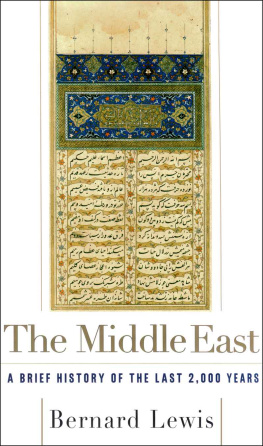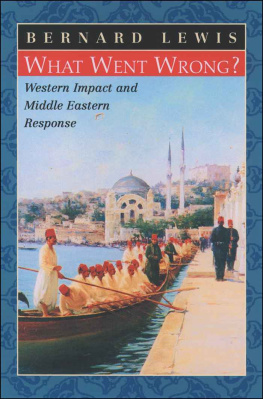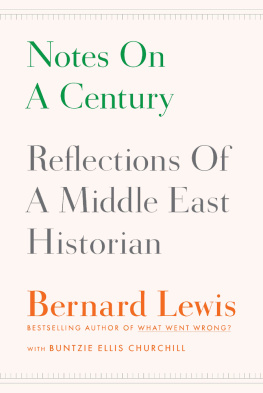Thank you for downloading this Scribner eBook.
Join our mailing list and get updates on new releases, deals, bonus content and other great books from Scribner and Simon & Schuster.
C LICK H ERE T O S IGN U P
or visit us online to sign up at
eBookNews.SimonandSchuster.com

OTHER BOOKS BY BERNARD LEWIS
Arabs in History
Islam and the West
Islam in History: Ideas, People, and Events in the Middle East
The Shaping of the Modern Middle East
Race and Slavery in the Middle East: Historical Enquiry
World of Islam
The Political Language of Islam
Islam: From the Prophet Muhammad to the Capture of Constantinople, Vol. I
Islam: From the Prophet Muhammad to the Capture of Constantinople, Vol. II
Semites and Anti-Semites
The Assassins: A Radical Sect in Islam
The Jews of Islam
The Muslim Discovery of Europe
The Origins of Ismailism: A Study of the Historical Background of the Fatimid Caliphate
The Muslim Discovery of Europe
Istanbul and the Civilization of the Ottoman Empire
Emergence of Modern Turkey
Middle East and the West


SCRIBNER
1230 Avenue of the Americas
New York, New York 10020
www.SimonandSchuster.com
Copyright 1995 Bernard Lewis
First published in Great Britain by Weidenfeld & Nicolson
All rights reserved, including the right of reproduction in whole or in part in any form.
SCRIBNER and design are trademarks of Simon & Schuster Inc.
3 5 7 9 10 8 6 4
Library of Congress Cataloging-in-Publication Data.
Lewis, Bernard.
The Middle East: a brief history of the last 2,000 years/Bernard Lewis.
p. cm.
Includes bibliographical references (p. ) and index.
1. Middle EastHistory. 1. Title.
DS62.L594 1996
956dc20 96-4384
CIP
ISBN 0-684-80712-2
ISBN-13: 978-0-684-83280-7
eISBN-13: 978-1-439-19000-5
CONTENTS
MAPS
ILLUSTRATIONS
Following page 212
The Roman emperor Constantine (Weidenfeld Archives)
Early Christian mosaic at Madaba (Weidenfeld Archives)
Justinian medallion (Ancient Art & Architecture Collection, London)
Synagogue at Dura Europos (National Museum, Damascus/Weidenfeld Archives)
The Dome of the Rock, Jerusalem (Weidenfeld Archives)
Inside the Dome of the Rock (Weidenfeld Archives)
The Mongols storm Baghdad in 1258 (Bibliothque Nationale, Paris/Bridgeman Art Library)
The tomb of Timur Lang in Samarqand (Weidenfeld Archives)
Sultan Bayezid I (Topkapi Museum, Istanbul/Weidenfeld Archives)
Sultan Murad II (Topkapi Museum, Istanbul/Weidenfeld Archives)
The castle of Rumeli Hisar (Weidenfeld Archives)
Mehmed the Conqueror (National Gallery, London)
Ottoman military parade (Gennadios Library, Athens/Weidenfeld Archives)
Janissary musketeers (Gennadios Library,Athens/Weidenfeld Archives)
The astronomer Taqi al Din in his observatory (Weidenfeld Archives)
Thirteenth-century astrolabe (British Museum/Weidenfeld Archives)
Illustration from Persian medical text (Bodleian Library, Oxford)
The Shah mosque, Isfahan (Weidenfeld Archives)
The madrasa Chehar Bagh, Isfahan (Ancient Art & Architecture Collection, London)
Shah Abbas receiving an ambassador (Ancient Art & Architecture Collection, London)
An Englishman in Ottoman service (Bodleian Library, Oxford)
Jewish doctor and merchant in Istanbul (Gennadios Library, Athens)
Dervishes (Weidenfeld Archives)
Dragoman (from O. Dalvimart, The Costume of Turkey, 1802)
Persian hunting scene (British Library/Weidenfeld Archives)
Turkish coffee-house (Mary Evans Picture Library)
The aga of the girls, a jester and a eunuch (Turkish postcard collection)
Ottoman military uniforms (Turkish postcard collection)
Ottoman officials with ambassadors (Turkish postcard collection)
Mahmud II before and after the destruction of the Janissaries (Topkapi Museum, Istanbul)
Muhammad Ali Pasha (Victoria & Albert Museum, London/Weidenfeld Archives)
Atatrk in uniform (Weidenfeld Archives)
Atatrk: the leader as teacher (Weidenfeld Archives)
The Arabian revolt, 1917 (Imperial War Museum, London)
Demonstrations in support of Ayatollah Khomeini (photo by A. Mingam/Frank Spooner Pictures)
Iranian women voting, 1979 (photo by A. de Wildenberg/Frank Spooner Pictures)
PREFACE
There are by now many one-volume histories of the Middle East. Most of them either end with the advent of Christianity or start with the advent of Islam. In commencing my history at the beginning of the Christian era, I seek to accomplish two purposes. The first is to rescue the two great empires of Persia and Byzantium from the modest place usually assigned to them, along with pre-Islamic Arabia, as part of the backdrop to the career of the Prophet and the founding of the Islamic state. These rival powers, which between them shared or divided the Middle East for many centuries, deserve more than cursory mention.
My second purpose is to establish some link between the Middle East that we know today and the ancient civilizations of the region that we know from ancient texts and monuments. During the early centuries of the Christian era, that is to say, in the period between Jesus and Muhammad, the regions west of the Persian Empire were transformed by the consecutive processes of Hellenization, Romanization and Christianization, and the memory (though not all the traces) of these ancient civilizations was obliterated. That memory was not restored until comparatively modern times, through the work of archaeologists and orientalists. But the direct continuing connection from the ancient to the modern Middle East, through Late Antiquity and the Middle Ages, deserves attention.
The earliest modern attempts to write the history of the region have necessarily concentrated on the sequence of political and military events, without which the deeper levels of history are difficult, if not impossible, to fathom. Thanks to the work of my predecessors, I have felt freer than they to reduce the political narrative to a minimum and to devote more attention to social, economic and, above all, cultural change. With this in view, I have made frequent use of direct quotations from contemporary sources - chronicles and travels, documents and inscriptions, and sometimes even poetry and anecdote. Where suitable English translations are available, I have used and cited them. Where they are not, I have made my own. The illustrations may also serve a similar purpose. From these, one may hope to obtain insights which neither narrative nor even analysis can readily yield.
Any attempt to present two thousand years of the history of a rich, varied and vibrant region within the compass of a single volume must necessarily omit much that is of importance. Every student of the region will make his or her own choice. I have made mine, and it is inevitably personal. I have tried to give due prominence to what seemed to me the most characteristic and most instructive careers, events, trends and achievements. The reader will judge how far I have succeeded.
Finally, it is my pleasant duty to record my thanks and appreciation to four young scholars at Princeton University, David Marmer, Michael Doran, Kate Elliott and Jane Baun. All of them have helped in various ways in the preparation and production of this book. I am particularly indebted to Jane Baun, whose meticulous scholarship and critical acuity were at all times of the greatest value. I should also like to express my gratitude to my assistant Annamarie Cerminaro, for her careful and patient handling of the many versions of this book, from first draft to final copy. In the editing, illustration and publication of this book I benefited enormously from the skill and patience of Benjamin Buchan, Tom Graves, and the indexer Douglas Matthews. They did much both to speed the process of production and to improve the quality of the product.
Next page














